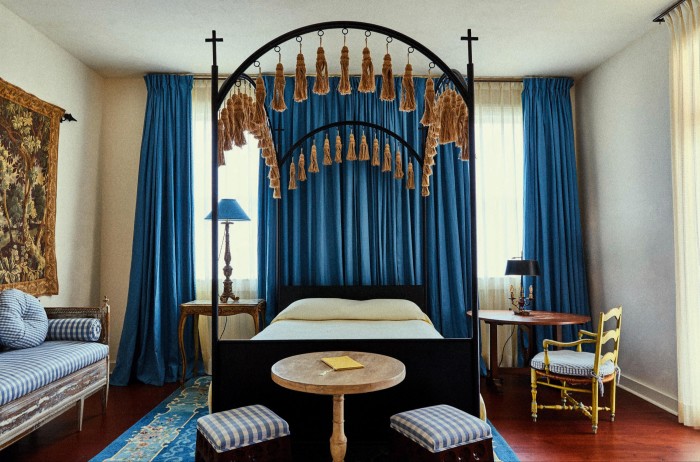The fairytale romance of the four-poster

Roula Khalaf, Editor of the FT, selects her favourite stories in this weekly newsletter.
“Who isn’t excited to sleep in a four-poster bed?” asks Charlotte Freemantle, the co-owner of Jamb, Pimlico Road’s purveyor of fireplaces, lighting, antique furnishings – and now four-poster beds. “It’s the stuff of dreams.”
That sense of fantasy and romance was front and centre in Freemantle’s mind when it came to her first decorating job at Aldourie Castle, a resplendent and rentable 12-bedroomed fort on the shores of Loch Ness. As the project progressed, what kept Freemantle up at night was the scarcity of beds to fill its rooms. “I’d suddenly panic and ask Will [Fisher, her partner and co-owner of Jamb] ‘How are we going to find 12 beds?’” she recalls.

Aldourie became the catalyst for realising their own vision of the perfect four-poster. They have since launched three designs – two with canopies and one without – that draw on the craftwork and artistry of four-posters past. “You couldn’t tell that this bed isn’t an 18th-century original,” says Fisher of the Palmira, a revival of an 1760s example that melds ornamental Thomas Chippendale-style relief work with the patina of painted decoration in chalky white and teal blue. The only clue to their modernity is their scale – more diminutive in height, and more expansive and standardised in their dimensions (necessary unless you want to shell out for a customised mattress and bedding for an antique original).

For Fisher, four-posters have a similar architectural gravitas to Jamb’s high-end reproduction fireplaces. “Getting the bed right is not only essential to the main bedrooms, but to the hierarchy and the feel of the whole house,” he says. That can certainly be felt at Aldourie, where Freemantle worked closely with bespoke curtain maker Emma Stewart to dress the many four-posters – some original and some of their own design – using textiles that conjure distinctive atmospheres. Yet even without fabrics, Freemantle believes, four-posters can bring grandeur and a sense of occasion to a room.

“They’re pure theatre,” agrees interior designer, antiques dealer and furniture maker Max Rollitt, who has been fashioning four-posters – coveted by everyone from Faye Toogood to Joanna Plant and Rita Konig – since 2018. “Four-posters are all about bringing joy and a sense of fun to a bedroom.” In 2010, the designer picked up a George III carved mahogany bedpost at a Chatsworth House attic sale at Sotheby’s. Thought once to have been housed in the Dorset Square home of the Duke and Duchess of Devonshire, this circa-1770, stop-fluted column has become the starting point for Rollitt’s new and magnificent Devonshire bed. It is made from American black walnut, with tulipwood side rails, using the same hand-executed joinery, craft skill and classical sensibility as the 18th-century original, and swathed in no less than 60m of Schumacher’s aptly named Le Max textile. The intention, says Rollitt, is to conjure a sense of intimacy, creating an interior room.

“Historically, these textiles would have been used to keep warmth in, and to maintain a sense of privacy,” he says. He’s not wrong. Queen Elizabeth I reportedly had 18 so-called “bodyguards of the bed” in her chamber each night. Although four-posters may date to the days of the Pharaohs, they first emerged in England between the 15th and 16th centuries, when however intricate their frames were, their mattresses would have been made from straw or feathers. Yet, with their curtains closed and interior candles lit, the bed would become more than simply a signal of wealth and status – it would be a precious inner sanctum.

Fantasy and practicality translate well to the modern interior. Having a bed enclosed and enveloped by fabrics, says Rollitt, means that you can dispense with the fuss or flourish of curtains elsewhere in the room. When stripped back, even antique four-posters take on their own sculptural sensibility – regardless of the scale of the room.
“It’s an easy way to renovate your space,” says Ari S Heckman, co-founder and CEO of Ash, a New York-based hotelier and interior design firm. “In a bedroom it becomes an impactful element that’s a room within a room,”
At Hotel Peter & Paul, a former 19th-century church, school house, rectory and convent in New Orleans, Ash designed wrought-iron four-posters draped in gingham checks; at the Ulysses in Baltimore the team installed Amish-made wooden beds with lavish painted finials; and for the forthcoming Shenandoah Mansions, opening this autumn in Richmond, Virginia, high beds will be heavily dressed in textiles that borrow from English and colonial American styles. For an easy update, Heckman suggests hanging reams of fabric from the ceiling to create “a beautiful, diaphanous but soft structure”.

When the London interior designer Rachel Chudley installed a custom four-poster into the high-ceilinged, but not huge, bedroom of a British playwright, it formed a frame for surveying the room. “There’s nothing quite like a four-poster for its drama, architectural scale – and versatility,” says Chudley, who points to the designs of Les Lalanne as proof of its sheer flamboyance. The designer duo’s Le Cocodoll bed – essentially an egg-like bird body with large bronze feet – once graced the apartment of French decorator Jacques Grange.
Perhaps the most famous high bed in English history is the late-16th-century Great Bed of Ware. Now in the V&A museum, but once housed in a Hertfordshire coaching inn, it measures more than 3m wide – nearly twice the size of the typical Elizabethan bed. With a bawdy reputation immortalised by both Byron and Shakespeare, and comfortably accommodating four couples at a time, it is said one night to have sheltered no less than 26 frolicking butchers and their wives. Playful, provocative – and proof that there is nothing new under the canopy.
Comments